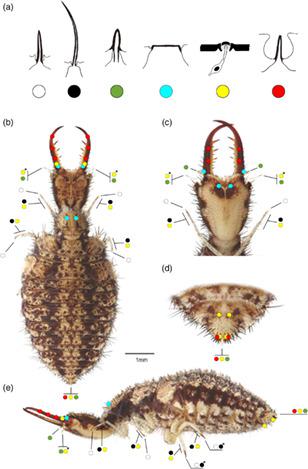当前位置:
X-MOL 学术
›
J. Morphol.
›
论文详情
Our official English website, www.x-mol.net, welcomes your
feedback! (Note: you will need to create a separate account there.)
Comparative study of sensilla and other tegumentary structures of Myrmeleontidae larvae (Insecta, Neuroptera)
Journal of Morphology ( IF 1.5 ) Pub Date : 2020-08-20 , DOI: 10.1002/jmor.21240 Fernando Acevedo Ramos 1, 2 , Víctor J Monserrat 1 , Atilano Contreras-Ramos 2 , Sergio Pérez-González 1
Journal of Morphology ( IF 1.5 ) Pub Date : 2020-08-20 , DOI: 10.1002/jmor.21240 Fernando Acevedo Ramos 1, 2 , Víctor J Monserrat 1 , Atilano Contreras-Ramos 2 , Sergio Pérez-González 1
Affiliation

|
Antlion larvae have a complex tegumentary sensorial equipment. The sensilla and other kinds of larval tegumentary structures have been studied in 29 species of 18 genera within family Myrmeleontidae, all of them with certain degree of psammophilous lifestyle. The adaptations for such lifestyle are probably related to the evolutionary success of this lineage within Neuroptera. We identified eight types of sensory structures, six types of sensilla (excluding typical long bristles) and two other specialized tegumentary structures. Both sensilla and other types of structures that have been observed using scanning electron microscopy show similar patterns in terms of occurrence and density in all the studied species (with few exceptions). The sensilla identified are: coeloconica, placoidea, basiconica, trichodea type I, trichodea type II, and campaniformia. All these sensilla have mechano‐ or chemosensorial functions. Some regions of the larval body have been studied using SEM for the first time, such as the surface of the food canal, which bears sensilla coeloconica, and the abdominal segment X, that bears three types of sensilla: coeloconica, basiconica, and campaniformia. Sensilla placodea are newly reported on antlion larvae, being present on the mandibular base, pronotum, mentum, and cardum. Also, new locations of sensilla coeloconica (e.g., on rastra) and sensilla campaniformia (e.g., on odontoid processes) are noted. A novel porous texture with chemoreceptor function has been identified in the base of mandibles. A mechanism of dentate‐notched surfaces that anchor maxillae and mandible, reinforcing the food canal, is detailed. All these sensorial structures, in addition to ocular tubercles for light caption and their great muscular system, confer to these larvae an extraordinary predation capacity to success hunting and living in such harsh environments.
中文翻译:

桃金娘科幼虫(昆虫纲、神经翅目)的感受器和其他外皮结构的比较研究
蚁狮幼虫有复杂的外皮感觉设备。已在桃金娘科18属29种中研究了感器和其他种类的幼虫体表结构,它们都具有一定程度的嗜砂性生活方式。这种生活方式的适应可能与神经翅目中该谱系的进化成功有关。我们确定了八种类型的感觉结构、六种类型的感受器(不包括典型的长刷毛)和另外两种特殊的外皮结构。使用扫描电子显微镜观察到的感受器和其他类型的结构在所有研究物种的发生率和密度方面都显示出相似的模式(少数例外)。鉴定出的感受器是:腔肠菌属、扁藻纲、基本菌纲、毛虫 I 型、毛虫 II 型、和钟形。所有这些感觉器都具有机械或化学感应功能。首次使用扫描电镜研究了幼虫身体的一些区域,例如带有腔感受器的食物管表面和带有三种类型的感受器:腔腔感受器、基本感受器和钟形感受器的腹段 X。新报告了在蚁狮幼虫上的 Sensilla placodea,它们存在于下颌基部、前胸膜、颌骨和贲门上。此外,还注意到腔腔感受器(例如,在 rastra)和钟形感受器(例如,在齿状突上)的新位置。在下颌骨底部发现了一种具有化学感受器功能的新型多孔结构。详细介绍了固定上颌骨和下颌骨、加强食道的齿状缺口表面的机制。所有这些感官结构,
更新日期:2020-08-20
中文翻译:

桃金娘科幼虫(昆虫纲、神经翅目)的感受器和其他外皮结构的比较研究
蚁狮幼虫有复杂的外皮感觉设备。已在桃金娘科18属29种中研究了感器和其他种类的幼虫体表结构,它们都具有一定程度的嗜砂性生活方式。这种生活方式的适应可能与神经翅目中该谱系的进化成功有关。我们确定了八种类型的感觉结构、六种类型的感受器(不包括典型的长刷毛)和另外两种特殊的外皮结构。使用扫描电子显微镜观察到的感受器和其他类型的结构在所有研究物种的发生率和密度方面都显示出相似的模式(少数例外)。鉴定出的感受器是:腔肠菌属、扁藻纲、基本菌纲、毛虫 I 型、毛虫 II 型、和钟形。所有这些感觉器都具有机械或化学感应功能。首次使用扫描电镜研究了幼虫身体的一些区域,例如带有腔感受器的食物管表面和带有三种类型的感受器:腔腔感受器、基本感受器和钟形感受器的腹段 X。新报告了在蚁狮幼虫上的 Sensilla placodea,它们存在于下颌基部、前胸膜、颌骨和贲门上。此外,还注意到腔腔感受器(例如,在 rastra)和钟形感受器(例如,在齿状突上)的新位置。在下颌骨底部发现了一种具有化学感受器功能的新型多孔结构。详细介绍了固定上颌骨和下颌骨、加强食道的齿状缺口表面的机制。所有这些感官结构,











































 京公网安备 11010802027423号
京公网安备 11010802027423号